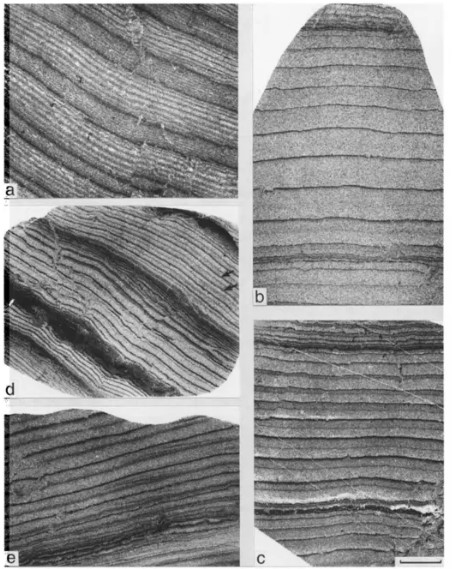Yet we don't. Instead, the tidal pull of the moon was halted for over a billion years. For that, we can thank the pull of the sun. This tidal stalemate between the sun and moon has been linked to the atmosphere’s temperature and Earth’s rotational rate.
When the moon first formed some 4.5 billion years ago, the day was less than 10 hours long. But since then, the moon’s gravitational pull on the Earth has been slowing our planet’s rotation, resulting in an increasingly longer day. The moon slows the planet’s rotation by pulling on Earth’s oceans, creating tidal bulges on opposite sides of the planet that we experience as high and low tides. The gravitational pull of the moon on those bulges, plus the friction between the tides and the ocean floor, acts like a brake on our spinning planet.

Samples from a tidal estuary that reveal the cycle of spring and neap tides. Credit:
G.E. Williams
The sun also produces an atmospheric tide with the same type of bulges, The sun's gravity pulls on these atmospheric bulges, producing a torque on the Earth. But instead of slowing down Earth’s rotation like the moon, it speeds it up. Yet for most of our recent geological history, the lunar tides have overpowered the solar tides by about a factor of ten; hence, the Earth’s slowing rotational speed and lengthening days.
Two billion years ago, the atmospheric bulges were larger because the atmosphere was much warmer and its natural resonance — the frequency at which waves move through it — matched the length of the day. Just like a bell always produces the same note if its temperature is constant, the atmosphere also has a resonant frequency. Yet most of the time in history atmospheric resonance has been out of sync with the planet’s rotational rate. For example, now each of the two atmospheric “high tides” take 22.8 hours to travel around the world. Since the resonance and Earth’s 24-hour rotational period are out of sync, the atmospheric tide is relatively small.
When the atmosphere was warmer and resonated with a period of about 10 hours, Earth’s rotation, slowed by the moon, reached 20 hours. When they coincided the atmospheric tide was reinforced, the bulges became larger and the sun’s tidal pull became strong enough to counter the lunar tide.





Comments